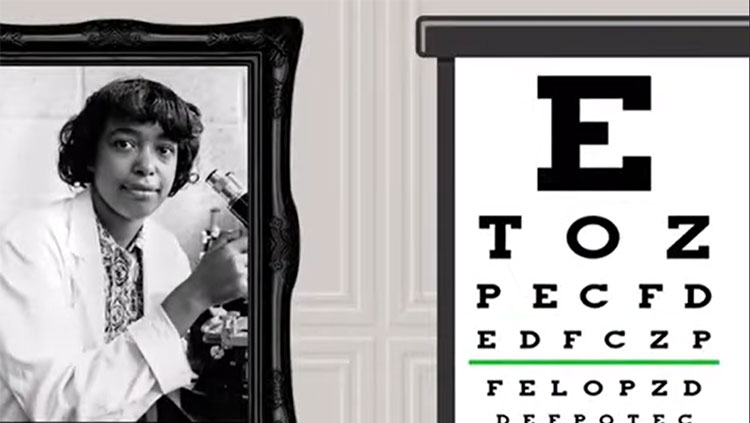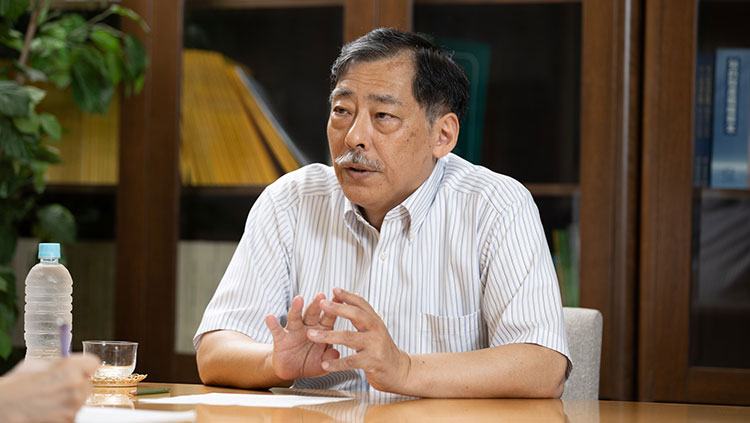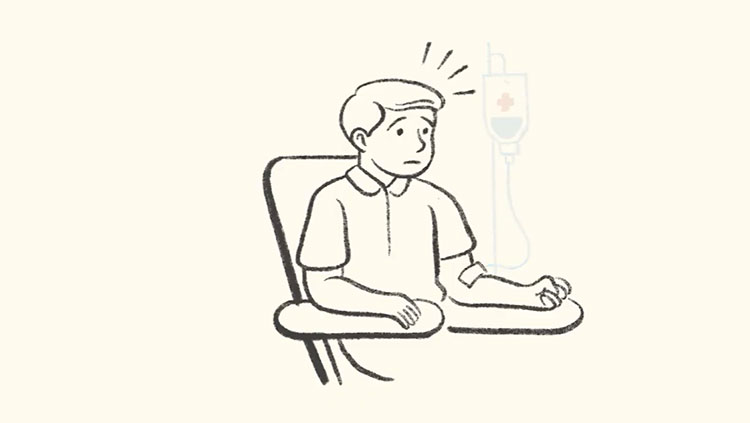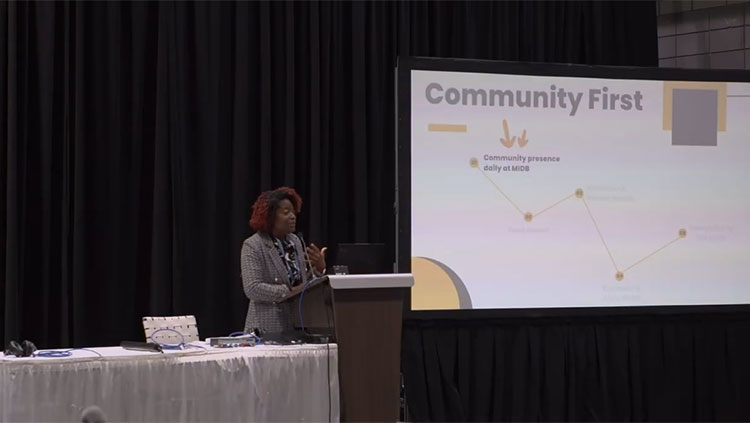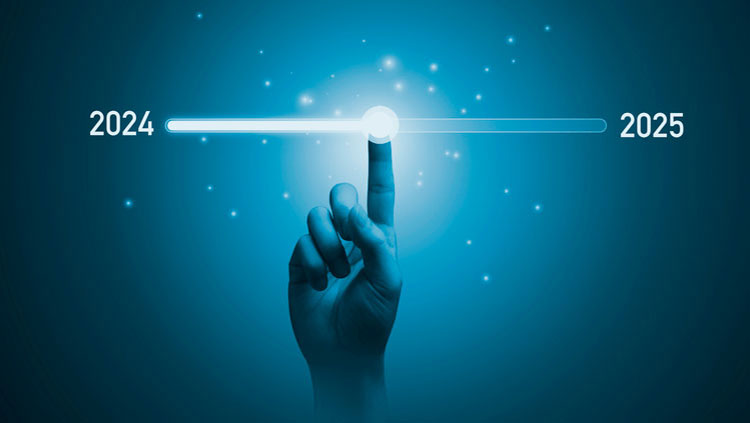Researchers Create First Adult Fruit Fly Brain Connectome
- Published7 Nov 2024
- Author Tristan Rivera
- Source BrainFacts/SfN
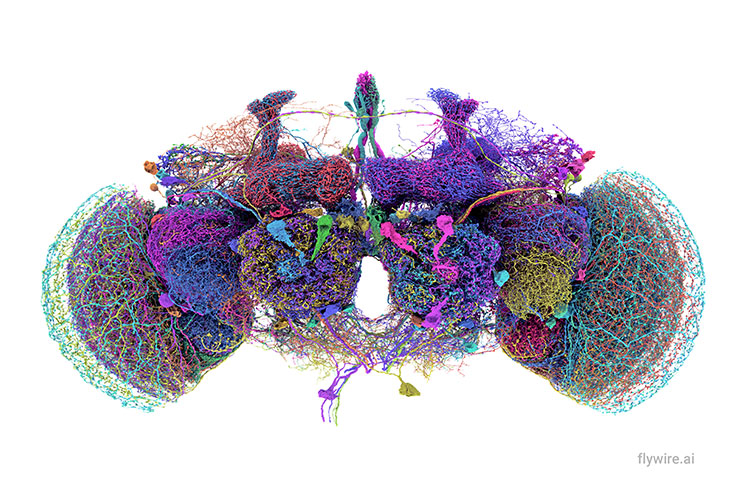
If you thought piecing together a 1000-piece puzzle was a challenge, try building a map of all the nerve cells in the brain. With the support of artificial intelligence (AI), scientists solved a 3D puzzle 21,000 times the size of our weekend-hobby to create a full neuronal map of a fruit fly’s brain.
The first-ever complete brain connectome, or neural wiring diagram, of an adult female fruit fly is freely open through FlyWire. The feat, highlighted across a set of nine papers in Nature published in October, details a collaborative effort mapping over 50 million connections among nearly 140,000 neurons of the fruit fly, showing how neurons connect across their chemical synapses.
The papers reflect the tool’s potential. Two papers highlight the work creating the map of the FlyWire brain, while the other seven showcase how researchers have started to use the data: identifying new neural circuits involved in fruit fly senses, social interaction, and movement among others.
The work uncovered thousands of new neural cell types, and researchers continue to investigate how neurons across this map affect one another — unlocking a new level for neuroscience research on the common fruit fly and eventually other organisms.
Charting the Course
A longstanding animal model in neuroscience research, the common fruit fly (Drosophila melanogaster) has provided insights into brain development and behavior for over 100 years.
Researchers found there are many shared genetic similarities between us and these small organisms. “75% of the disease-related genes in humans have homologues in the Drosophila genome,” said Sebastian Seung in a press conference at Neuroscience 2024, the Society for Neuroscience’s annual meeting, in Chicago. Seung is a professor at Princeton University and co-leader of the FlyWire Consortium: a global group of more than 200 people across 50 labs who worked on the FlyWire connectome. Understanding these homologues, or shared genetic similarities, comes in handy when looking at possible treatments for many existing and emerging conditions.
A complete fruit fly genome has been available since 2000, but scientists had not had a comprehensive picture of the fly’s neural anatomy. In September 2020, a connectome was created for a fruit fly’s hemibrain, a large portion of the fly’s central brain. In March 2023, the first full connectome of a larval fruit fly was released — mapping nearly 550,000 connections across its 3,016 neurons.
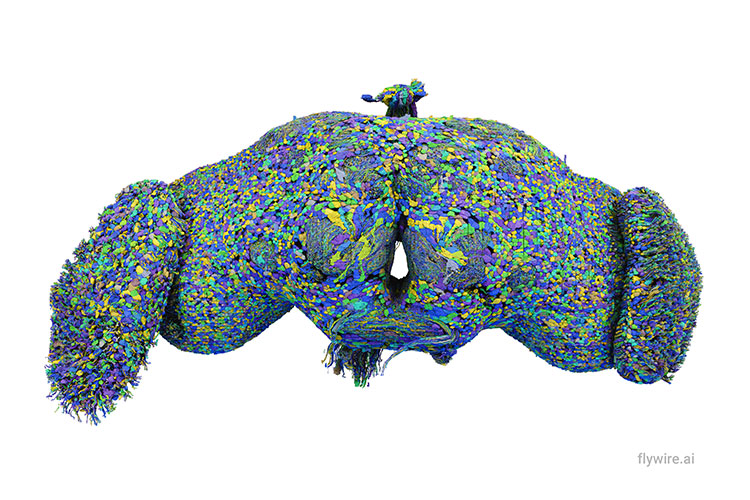
The new adult fruit fly map allows scientists to work through simulations using the FlyWire platform, letting them more quickly predict how precise, targeted experimental treatments may impact its neurons. “I think it is basically the beginning of a huge number of studies,” said Martha Bhattacharya, associate professor of neuroscience at the University of Arizona. When using the map to study the fly’s neural circuits, “you can really follow the information flow in a way that wasn’t possible before,” says Bhattacharya who uses fruit flies in her research but was not involved in creating the FlyWire map.
Through FlyWire’s main web app, Codex — or Connectome Data Explorer — people can access the fruit fly connectome anywhere with internet, allowing them to navigate through connections, take snapshots of cells, and see how neurons connect. “Really anybody can make discoveries in the data,” said Mala Murthy, director of the Princeton Neuroscience Institute and co-leader of the FlyWire Consortium.
The hope is the tool will refine fruit fly investigations and inform research for other animals and humans. “For bigger brains and larger maps, the projects are going to have to be open in this way,” said Murthy at the press conference. She notes future connectomes will openly need to draw in experts from all sectors to “proofread” the map and to provide the software innovation for building more complex brain diagrams.
Solving the Puzzle
The FlyWire Consortium incorporated neuroimaging tools, AI, and numerous scientists and volunteers to create this major diagram. The four-year project was funded by the NIH Brain Research Through Advancing Innovative Neurotechnologies® (BRAIN) Initiative, National Science Foundation, Wellcome Trust, the UK Research and Innovation’s Medical Research Council, Princeton University, Intelligence Advanced Research Projects Activity (IARPA), Google, and Amazon.
Initial work led by Davi Bock, currently an associate professor at the University of Vermont College of Medicine, spurred his team to gather 21 million images from 7,050 slices of the fly’s brain using electron microscopy. But “somehow, you have to assemble this jigsaw puzzle in three-dimensions back into a coherent volume,” said Bock at the press conference.
From those individual images, the FlyWire team used AI tools to detect synapses, segment the images, and then piece together a full map of the brain. To verify the AI-informed data was correct, scientists needed to manually check the data for errors. So, researchers connected with the larger fly neuroscience community to help.
According to Nature, similar to efforts to model the mouse retina and zebrafish hindbrain from Seung’s lab at Princeton University inspired his team to build FlyWire as a game-like setup, where volunteer scientists could put together 3D models of neurons. The 100 top-performing players to piece together neurons were later trained to detect other cell types. Those volunteers could then work on the project — checking the AI-generated synapses and neurons. The map had to be labeled, too. So, researchers and volunteers labeled each neuron to ensure cell type names were correct.
“We had an elite group of citizen scientists, actually — and they together proofread 18,000 neurons, and they annotated, or added cell type labels, to over 38,000 neurons in the fly brain,” Amy Sterling said at the press conference. Sterling is the Executive Director of Eyewire, a game mapping the neurons of a mouse retina from Seung’s lab, which inspired the design of the FlyWire platform. After labeling the map, researchers identified 8,453 cell types, with 4,581 of those being newly discovered. FlyWire researchers estimated the map would have needed 33 scientists working full time for a year to finish.
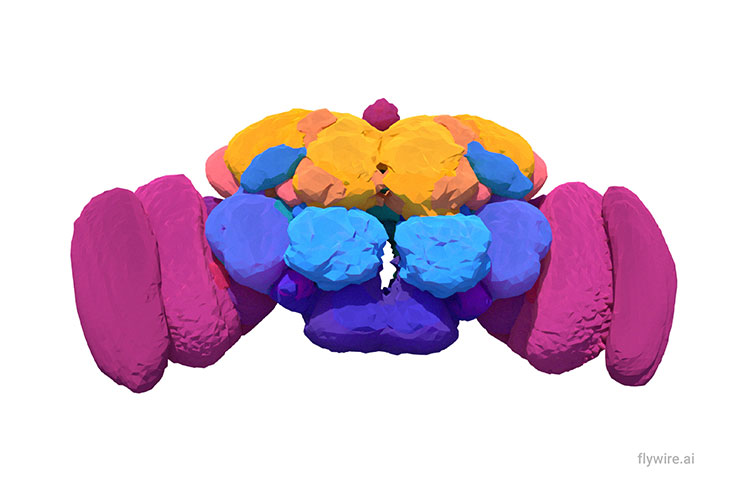
FlyWire researchers are now looking into interactions between neurons along the map. “The network is very complicated … within four hops — four connections — almost every neuron in the brain can communicate with every other neuron in the brain,” Murthy said. In years to come, as new maps and tools emerge, researchers will likely be able to combine toolkits together to generate better ideas about brain connections and behavior.
CONTENT PROVIDED BY
BrainFacts/SfN
References
Dorkenwald, S., Matsliah, A., Sterling, A. R., Schlegel, P., Yu, S. C., McKellar, C. E., Lin, A., Costa, M., Eichler, K., Yin, Y., Silversmith, W., Schneider-Mizell, C., Jordan, C. S., Brittain, D., Halageri, A., Kuehner, K., Ogedengbe, O., Morey, R., Gager, J., Kruk, K., … FlyWire Consortium (2024). Neuronal wiring diagram of an adult brain. Nature, 634(8032), 124–138. https://doi.org/10.1038/s41586-024-07558-y
Dorkenwald, S., McKellar, C. E., Macrina, T., Kemnitz, N., Lee, K., Lu, R., Wu, J., Popovych, S., Mitchell, E., Nehoran, B., Jia, Z., Bae, J. A., Mu, S., Ih, D., Castro, M., Ogedengbe, O., Halageri, A., Kuehner, K., Sterling, A. R., Ashwood, Z., … Seung, H. S. (2022). FlyWire: online community for whole-brain connectomics. Nature methods, 19(1), 119–128. https://doi.org/10.1038/s41592-021-01330-0
Fruitfly Genome Sequencing. (2012). National Human Genome Research Institute. https://www.genome.gov/11008080/fruitfly-genome-sequencing
Matsliah, A., Sterling, A. R., Dorkenwald, S., Kuehner, K., Morey R., Seung H. S., Murthy M. (2023). Codex: Connectome Data Explorer. http://dx.doi.org/10.13140/RG.2.2.35928.67844
Reardon, S. (2024). Largest brain map ever reveals fruit fly’s neurons in exquisite detail. Nature. https://www.nature.com/articles/d41586-024-03190-y
Researchers fully map neural connections of the fruit fly brain. (2024). National Institutes of Health. https://www.nih.gov/news-events/news-releases/researchers-fully-map-neural-connections-fruit-fly-brain
Scheffer, L. K., Xu, C. S., Januszewski, M., Lu, Z., Takemura, S. Y., Hayworth, K. J., Huang, G. B., Shinomiya, K., Maitlin-Shepard, J., Berg, S., Clements, J., Hubbard, P. M., Katz, W. T., Umayam, L., Zhao, T., Ackerman, D., Blakely, T., Bogovic, J., Dolafi, T., Kainmueller, D., … Plaza, S. M. (2020). A connectome and analysis of the adult Drosophila central brain. eLife, 9, e57443. https://doi.org/10.7554/eLife.57443
The FlyWire connectome: neuronal wiring diagram of a complete fly brain. (2024). Nature. https://www.nature.com/immersive/d42859-024-00053-4/index.html
Use citizen science to turbocharge big-data projects. (2024). Nature. https://www.nature.com/articles/d41586-024-03182-y
Winding, M., Pedigo, B. D., Barnes, C. L., Patsolic, H. G., Park, Y., Kazimiers, T., Fushiki, A., Andrade, I. V., Khandelwal, A., Valdes-Aleman, J., Li, F., Randel, N., Barsotti, E., Correia, A., Fetter, R. D., Hartenstein, V., Priebe, C. E., Vogelstein, J. T., Cardona, A., & Zlatic, M. (2023). The connectome of an insect brain. Science, 379(6636), eadd9330. https://doi.org/10.1126/science.add9330
Zheng, Z., Lauritzen, J. S., Perlman, E., Robinson, C. G., Nichols, M., Milkie, D., Torrens, O., Price, J., Fisher, C. B., Sharifi, N., Calle-Schuler, S. A., Kmecova, L., Ali, I. J., Karsh, B., Trautman, E. T., Bogovic, J. A., Hanslovsky, P., Jefferis, G. S. X. E., Kazhdan, M., Khairy, K., … Bock, D. D. (2018). A Complete Electron Microscopy Volume of the Brain of Adult Drosophila melanogaster. Cell, 174(3), 730–743.e22. https://doi.org/10.1016/j.cell.2018.06.019
What to Read Next
Also In Supporting Research
Trending
Popular articles on BrainFacts.org





